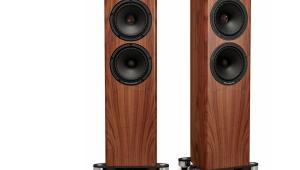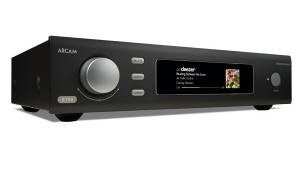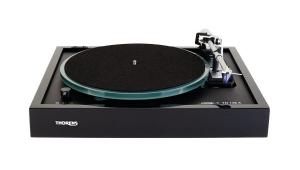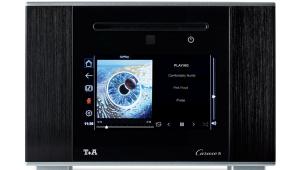Tannoy Revolution XT 6F

 When a 90-year-old company has become so famous that its name is synonymous with the things it produces, perhaps there’s a temptation to rest on one’s laurels. After all, everything has been said and done, hasn’t it? Well Dr Paul Mills, Tannoy’s director of development, does not take that view. Indeed, he has just finished work on a substantial revamp of the very thing for which the company is famous – its Dual Concentric driver.
When a 90-year-old company has become so famous that its name is synonymous with the things it produces, perhaps there’s a temptation to rest on one’s laurels. After all, everything has been said and done, hasn’t it? Well Dr Paul Mills, Tannoy’s director of development, does not take that view. Indeed, he has just finished work on a substantial revamp of the very thing for which the company is famous – its Dual Concentric driver.
This has given Tannoy its distinctive sound over the years, and does some things better than conventional loudspeakers. By keeping the tweeter and the midrange (and usually bass) units together on the same plane, it makes for a far more phase-coherent sound, which gives soundstaging and pin-point image location. The recent revamp of the Dual Concentric is said to be, “a major milestone in more than 65 years of the company’s audio research and development”, no less.
It has a new Omnimagnet motor and Torus dome tweeter with Ogive waveguide. The concentric mid/bass and treble drivers now share the same magnet, and a special waveguide integrating a donut-shaped (Torus) tweeter diaphragm and bullet-shaped (Ogive) phase plug. Tannoy has moved the tweeter forward for better time alignment, and the new shallower but more flared waveguide is said to give better high-frequency directivity and low-frequency performance, enabling a higher crossover point. The tweeter uses a 25mm PEI dome, and this sits in front of the 150mm multi-fibre paper mid/bass unit with a 44mm voice coil.
The XT 6 is more than just a clever driver, though. In a bid to minimise loss, care has been taken to give an ‘ultra-clean’ signal path, so the crossover has been specially designed with this in mind, and good-quality components are used. Large, gold-plated bi-wire binding posts round the back let you affix decent cable, too. This all sits in a new cabinet with down-firing port exiting to an integral base. This is what gives the Revolution XT 6 and its siblings – the (£1,299) XT 8F floorstander, (£999) XT 6F floorstander – reviewed HFC 400 – and (£399) XT C centre – its most distinctive visual aspect.
The speaker is well made and finished for its price, with fairly substantial cabinets that aren’t resonant when you knock them. The review sample has a good dark walnut real wood veneer, although medium oak is also available. It’s reasonably easy to drive for a smallish stand mounter, with a quoted efficiency of 89dB. The Exposure 3010S2-D (HFC 397) that I use with its claimed 110W RMS per channel rated power is more than enough; Tannoy says anything over 25W should suffice.
Sound quality
Having recently reviewed the XT 6F, it’s clear that there’s a strong family resemblance in terms of sound. Obviously, the XT 6 lacks its bigger brother’s additional bass driver and cabinet volume, so there’s an octave or so of bass missing. However, you don’t miss it because the little 6 has the ability to draw you away from its shortcomings, and let you focus on what it does well, giving a charming and exuberant performance that makes music fun.
The Kinks’ Village Green Preservation Society is a jaunty, melodic slice of late sixties rock, and the Tannoy captures it perfectly. Bouncy, fun and tuneful, it doesn’t attempt to get right down into the mix and throw out the finest forensic details, instead preferring to give a rousing and musical rendition of this singalong song. There are speakers at 10 times the price that get bogged down trying to tell you how rudimentary the recording quality is, and end up sounding
far less enjoyable in the process.
Tannoy has given this little speaker a pleasingly fulsome bass that provides a subtle push to basslines on rock, pop and soul. It doesn’t go down as low as the XT 6F, yet on first listen sounds almost as commanding. The 6F is obviously more even and initially less ‘impressive’, whereas its smaller brother certainly makes an entrance. This warmth extends all
the way up; this isn’t one of those speakers that etches the sound on your cranium with a laser beam. The midband is smooth and expansive; thanks in no small part to the Dual Concentric driver, the Tannoy is exceptionally good at projecting sound out into the room and this contributes to its friendly nature. Some speakers sound like they’re trying to squeeze the sound out through a toothpaste tube, but the XT 6 is never forced. The soundstage hangs in the room with the speakers dissolving away into the ether. Images project into space with total ease, and the smoothness of the midband makes this all the more enjoyable.
Coldplay’s Speed Of Sound showcases this fantastic midband perfectly. It’s a big, stadium rock-style belter and the Tannoy duly delivers a cathedral-like recorded acoustic, almost as if you’d pressed the ‘stereo wide’ button on an eighties radio cassette portable. As well as those big, bold stereo images, the XT 6 again goes straight for the melodic content of the music, throwing out those big crashing keyboards and intricate guitar noodling. It also carries the lead vocal very well, sounding quite ethereal and located positively within the mix. The midband blends seamlessly with the treble, so you never get the impression you’re listening to two separate drive units. The dome tweeter, inset into the mid/bass driver, gives a crisp sound with decent detailing.
It is only when you feed the Tannoy with some slightly more dense, impenetrable programme material that it begins to show its mortality. 808 State’s Pacific 707 is a classic rave track from the late eighties, and is not especially well recorded. It can sound muddy through all but the very best loudspeakers and here we begin to observe that this little Tannoy isn’t quite perfect. It remains great fun to listen to, being bouncy and involving with excellent rhythms and a pleasingly warm tonality (whereas sometimes this track can seem a little ‘digital’ and cold). However, the XT 6 doesn’t pick through the mix quite as well as it should, sounding slightly congested. The mid/bass cone has a subtle but distinct coloration and it seems to take away some transparency. All speakers suffer this in one way or another, of course, especially at this price.
The first movement of Beethoven’s 5th Symphony again shows the XT 6’s superb soundstaging, although the massed strings don’t quite have the lustre that some rivals bring. However the little Tannoy’s ability to carry the spirit and emotion of the music is second to none – it makes this beautiful classical work all the more engaging and compelling. It’s a dramatic-sounding first movement, but this loudspeaker actually seems to heighten the epic feel still further. Partnered with a powerful amplifier like the Exposure, the size and power of the sound is totally unexpected given the price. Fascinatingly, it gives almost nothing away to its XT 6F bigger brother in this respect; indeed it seems even more lively and enjoyable than its sibling.
Conclusion
If you want a dutiful standmounter that will give you a neutral, matter-of-fact reading of every piece of music that you present it with, then the Tannoy Revolution XT 6 clearly isn’t for you. However, if it’s fun that you seek from your speakers, then this should be high on your list. An interesting and amiable little loudspeaker then, one which shows that Tannoy hasn’t lost its touch. DP
DETAILS
PRODUCT: Tannoy Revolution XT 6
PRICE: £600
ORIGIN: UK
TYPE: 2-way standmount loudspeaker
WEIGHT: 7.5kg
DIMENSIONS (WxHxD): 221 x 400 x 302mm
FEATURES
● 1x 150mm Dual Concentric driver with 25mm tweeter
● Quoted sensitivity: 89dB/1W/1m
DISTRIBUTOR: Tannoy Ltd
TELEPHONE: 01236 420199
WEBSITE: tannoy.co.uk
 Click here to read the full review
Click here to read the full review
 |
Inside this month's issue: Arcam Radia A25 integrated amp, iFi Audio iDSD Diablo 2 DAC/headphone amp, Eversolo DMP-A8 streamer/DAC/preamp, Line Magnetic LM-845IA valve amp, Record Store Day Spring Drop, standmount loudspeaker Group Test and much, much more
|













































.jpg)



